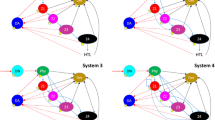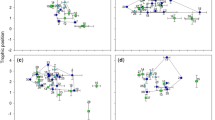Abstract
Widespread omnivory in aquatic food webs has been recognized to compromise interpretation of Lindeman’s “pyramid of energy” wherein organism biomass is constrained into rigidly delineated trophic levels. A compilation of global, pre-1997 stable nitrogen isotope data for aquatic food webs produced vertical energy profiles that were ataxonomic and therefore similar to Elton’s “pyramid of numbers” which he believed to be based on size-structured feeding relationships. Further, the present secondary-analysis confirms findings from other recent data compilations in suggesting that aquatic animals in real food webs are rarely found above the fifth or sixth broadly based trophic category. Therefore, δ15N analysis of food webs permits a reconciliation between theoreticians and empiricists by assuming a middle position in estimates made of the vertical length of food webs.


Similar content being viewed by others
References
Akin, S. & K. O. Winemiller, 2008. Body size and trophic position in a temperate estuarine food web. Acta Oecologia 33: 144–153.
Al-Habsi, S. H., C. J. Sweeting, N. V. Polunin & N. A. Graham, 2008. δ15N and δ13C elucidation of size-structured food webs in a Western Arabian Sea demersal trawl assemblage. Marine Ecology Progress Series 353: 55–63.
Burns, T. P., 1989. Lindeman’s contradiction and the trophic structure of ecosystems. Ecology 70: 1355–1362.
Cabana, G. & J. B. Rasmussen, 1994. Modelling food chain structure and contaminant bioaccumulation using stable nitrogen isotopes. Nature 372: 255–257.
Cohen, J. E. & C. M. Newman, 1985. A stochastic theory of community food webs I. Models and aggregated data. Proceedings of the Royal Society of London Series B 224: 421–448.
Cohen, J. E., F. Briand & C. M. Newman, 1986. A stochastic theory of community food webs. III. Predicted and observed lengths of food chains. Proceedings of the Royal Society of London Series B 238: 317–353.
Cohen, J. E., T. Jonsson & S. R. Carpenter, 2003. Ecological community description using the food web, species abundance, and body size. Proceedings of National Academy Science of the United States of America 100: 1781–1786.
Cousins, S., 1985. Ecologists build pyramids again. New Scientist 1463: 50–54.
del Giorgio, P. A. & R. L. France, 1996. Ecosystem-specific patterns in the relationship between zooplankton and POM or microplankton δ13C. Limnology and Oceanography 41: 359–365.
Diehl, S., 1993. Relative consumer sizes and the strengths of and indirect interactions in omnivorous feeding relationships. Oikos 68: 151–157.
Diehl, S., 1995. Direct and indirect effects of omnivory in a littoral lake community. Ecology 76: 1727–1740.
Elton, C., 1927. Animal Ecology. Sidgewick and Jackson Publ., London.
Evans-White, M., W. K. Dodds, L. J. Gray & K. M. Fritz, 2001. A comparison of the trophic ecology of the crayfishes (Orconectes nais (Faxon)) and the central stoneroller minnow (Campostoma anomalum (Rafinesque)): omnivory in a tallgrass prairie stream. Hydrobiologia 462: 131–144.
France, R. L., 1997. δ15N examination of the Lindeman–Hutchinson–Peters theory of increasing omnivory with trophic height in aquatic foodwebs. Researches on Population Ecology 39: 121–125.
France, R. L., 2012. Omnivory, vertical food-web structure and system productivity: stable isotope analysis of freshwater planktonic food webs. Freshwater Biology 57: 787–794.
France, R. L. & R. H. Peters, 1997. Ecosystem differences in the trophic enrichment of 13C in aquatic foodwebs. Canadian Journal of Fisheries and Aquatic Sciences 54: 1255–1258.
France, R. L., R. H. Peters & Y. T. Prairie, 1994. Adjusting chlorophyll-a estimates through temporal weighting based on the seasonal development of phytobiomass. Aquatic Sciences 56: 106–114.
France, R., K. Westcott, P. del Giorgio, G. Klein & J. Kalff, 1996. Vertical foodweb structure of freshwater zooplankton assemblages estimated by stable nitrogen isotopes. Researches on Population Ecology 38: 283–287.
France, R., M. Chandler & R. Peters, 1997. Mapping trophic continua of benthic foodwebs: body size-δ15N relationships. Marine Ecology Progress Series 174: 301–306.
France, R., J. Loret, R. Mathews & J. Springer, 1998. Longitudinal variation in zooplankton δ13C through the Northwest Passage: inference for incorporation of sea-ice POM into pelagic foodwebs. Polar Biology 20: 335–341.
Fry, B., 1991. Stable isotope diagrams of freshwater food webs. Ecology 72: 2293–2297.
Fry, B. & R. B. Quinones, 1994. Biomass spectra and stable isotope indicators of trophic level in zooplankton of the northwest Atlantic. Marine Ecology Progress Series 112: 201–204.
Gaedke, U., D. Straile, & C. Pahl-Wostl. 1996. Trophic structure and carbon flow dynamics in the pelagic community of a large lake. In Polis, G. A. & K. O. Winemiller (eds), Food Webs, Integration of Patterns & Dynamics. Chapman and Hall, New York: 60–714.
Goldwasser, I. & J. Roughgarden, 1993. Construction and analysis of a large Caribbean food web. Ecology 74: 1216–1233.
Hakanson, L. & R. H. Peters, 1995. Predictive Limnology: Methods for Predictive Modeling. SPB Academic Publishing, Amsterdam.
Hall, S. J. & D. G. Raffaelli, 1993. Food webs: theory and reality. Advances in Ecological Research 24: 187–239.
Holyoak, M. & S. Sachdev, 1998. Omnivory and the stability of simple food webs. Oecologia 117: 413–419.
Issacs, J. D., 1973. Potential trophic biomasses and trace substance concentrations in unstructured marine food webs. Marine Biology 22: 97–104.
Jennings, S. & K. J. Warr, 2003. Smaller predator–prey body size rations in longer food chains. Proceedings of the Royal Society of London Series B 270: 1413–1417.
Jennings, S., J. K. Pinnegar, N. V. Polunin & T. W. Boon, 2001. Weak cross-species relationships between body size and trophic level belie powerful size-based trophic structuring in fish communities. Journal of Animal Ecology 70: 934–944.
Jennings, S., J. K. Pinnegar, N. V. Polunin & K. J. Warr, 2002. Linking size-based and trophic analyses of benthic community structure. Marine Ecology Progress Series 226: 77–85.
Kling, G. W., B. Fry & W. J. O’Brien, 1992. Stable isotopes and planktonic trophic structure in arctic lakes. Ecology 73: 561–566.
Layman, C. A., K. O. Winemiller, D. A. Arrington & D. B. Jepsen, 2005. Body size and trophic position in a diverse tropical food web. Ecology 86: 2530–2535.
Lindeman, R. L., 1942. The trophodynamic aspect of ecology. Ecology 23: 399–418.
Martinez, N. D., 1991. Artifacts or attributes? Effects of resolution on the Little Rock Lake food web. Ecological Monographs 61: 367–392.
May, R. M., 1983. The structure of food webs. Nature 301: 566–568.
Mingawa, M. & E. Wada, 1984. Stepwise enrichment of 15N along food chains: further evidence and the relation to environmental stress and recruitment. Geochimica Cosmochimica Acta 48: 1135–1340.
Nakazawa, T., Y. Sakai, C. Hsieh, T. Koitashi, N. Yamamura & N. Okuda, 2010. Is the relationship between body size and trophic niche position time-invariant in a predatory fish? First stable isotope evidence. PLoS 5: 1–5.
Owens, N. J. P., 1987. Natural variations in 15N in the marine environment. Advances in Marine Biology 24: 389–451.
Pahl-Wostl, C., 1993. Food webs and ecological networks across temporal and spatial scales. Oikos 66: 415–432.
Paine, R. T., 1996. Preface. In Polis, G. A. & K. O. Winemiller (eds), Food Webs, Integration of Patterns & Dynamics. Chapman & Hall, New York.
Peters, R. H., 1986. The role of prediction in limnology. Limnology and Oceanography 31: 1143–1159.
Peters, R. H., 1988. Some general problems for ecology illustrated by food web theory. Ecology 69: 1673–1676.
Peters, R. H., 1993. Ecological Implications of Body Size. Cambridge University Press, Cambridge.
Pimm, S. L. & J. H. Lawton, 1977. Number of trophic levels in ecological communities. Nature 268: 329–331.
Pimm, S. L. & J. H. Lawton, 1978. On feeding on more than one trophic level. Nature 275: 542–544.
Polis, G. A., 1991. Complex trophic interactions in deserts: an empirical critique of food web theory. American Naturalist 138: 123–155.
Post, D. M., 2002a. Using stable isotopes to estimate trophic position: models, methods, and assumptions. Ecology 83: 703–708.
Post, D. M., 2002b. The long and short of food chain length. Trends in Ecology Evolution 17: 269–277.
Post, D. M. & G. Takimoto, 2007. Proximate structural mechanisms for variation in food-chain length. Oikos 116: 775–783.
Post, D. M., M. L. Pace & N. G. Hairston, 2000. Ecosystem size determines food-chain length in lakes. Nature 405: 1047–1049.
Saunders, P. T., 1978. Population dynamics and the length of food chains. Nature 272: 189–190.
Sprules, W. G. & J. E. Bowerman, 1988. Omnivory and food chain length in zooplankton food webs. Ecology 69: 418–426.
Strayer, D., 1992. Notes on Lindeman’s progressive efficiency. Ecology 72: 348–350.
Takimoto, G., D. A. Spille & D. M. Post, 2008. Ecosystem size, but not disturbance, determines food-chain length on islands of the Bahamas. Ecology 89: 3001–3007.
Thompson, R. M., M. Hemberg, B. M. Starzomski & J. B. Shurin, 2007. Trophic levels and trophic tangles: the prevalence of omnivory in real food webs. Ecology 88: 612–617.
Vadas, R. L., 1990. The importance of omnivory and predator regulation of prey in freshwater fish assemblages of North America. Environmental Biology of Fishes 27: 285–302.
Vadeboncoeur, Y., K. S. McCann, M. J. Vander Zanden & J. B. Rasmussen, 2005. Effects of multi-chain omnivory on the strength of trophic control in lakes. Ecosystems 8: 682–693.
Vander Zanden, M. J. & W. W. Fetzer, 2007. Global patterns of aquatic food chain length. Oikos 116: 1378–1388.
Vander Zanden, M. J. & J. B. Rasmussen, 1996. A trophic position model of pelagic food webs: impact on contaminant bioaccumulation in lake trout. Ecological Monographs 66: 451–477.
Vander Zanden, M. J. & J. B. Rasmussen, 2001. Variation in δ15N and δ13C trophic fractionation: implications for aquatic food web studies. Limnology and Oceanography 46: 2061–2066.
Vander Zanden, M. J., G. Cabana & J. B. Rasmussen, 1997. Comparing trophic position of freshwater fish calculated using stable nitrogen isotope ratios (δ15N) and literature dietary data. Canadian Journal of Fisheries and Aquatic Sciences 54: 1142–1158.
Vander Zanden, M. J., B. J. Shuter, N. Lester & J. B. Rasmussen, 1999. Patterns of food chain length in lakes: a stable isotope study. American Naturalist 154: 406–416.
Warren, P. H. & J. H. Lawton, 1987. Invertebrate predator-prey body size relationships: an explanation of upper triangularity in food webs and patterns in food web structure. Oecologia 74: 231–235.
Whall, J. D. & D. C. Lasenby, 2009. Differences in the trophic role of Mysis diluviana in two intermontane lakes. Aquatic Biology 5: 281–292.
Wilson, R. M., J. Chanton, G. Lewis & D. Nowacek, 2009. Isotopic variation (δ15N, δ13C, and δ34S) with body size in post-larval estuarine consumers. Estuarine, Coastal and Shelf Science 63: 307–312.
Winemiller, K. O., 1990. Spatial and temporal variation in tropical fish trophic networks. Ecological Monographs 60: 331–367.
Yodzis, P., 1981. The stability of real ecosystems. Nature 289: 674–676.
Yodzis, P., 1984. Energy flow and the vertical structure of real ecosystems. Oecologia 65: 86–88.
Author information
Authors and Affiliations
Corresponding author
Additional information
Handling editor: Katya E. Kovalenko
Rights and permissions
About this article
Cite this article
France, R.L. Rebuilding and comparing pyramids of numbers (Elton) and energy (Lindeman) with selected global δ15N data. Hydrobiologia 722, 1–7 (2014). https://doi.org/10.1007/s10750-013-1710-7
Received:
Revised:
Accepted:
Published:
Issue Date:
DOI: https://doi.org/10.1007/s10750-013-1710-7




